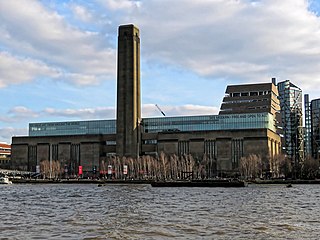
Tate Modern is an art gallery located in London. It houses the United Kingdom's national collection of international modern and contemporary art, and forms part of the Tate group together with Tate Britain, Tate Liverpool and Tate St Ives. It is located in the former Bankside Power Station, in the Bankside area of the London Borough of Southwark.
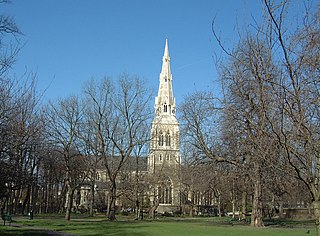
Camberwell is a district of South London, England, in the London Borough of Southwark, 2.7 miles (4.3 km) southeast of Charing Cross.

The London Borough of Southwark in south London forms part of Inner London and is connected by bridges across the River Thames to the City of London and London Borough of Tower Hamlets. It was created in 1965 when three smaller council areas amalgamated under the London Government Act 1963. All districts of the area are within the London postal district. It is governed by Southwark London Borough Council.
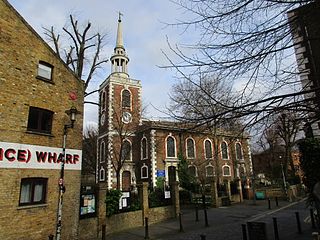
Rotherhithe is a residential district in south-east London, England, and part of the London Borough of Southwark. Historically the area was the most northeastern settlement in the county of Surrey. It is located on a peninsula on the south bank of the Thames, facing Wapping and Limehouse on the north bank, and is a part of the Docklands area. It borders Bermondsey to the west and Deptford to the south east.
Rotunda or The Rotunda may refer to:

Sir Ashton Lever FRS was an English collector of natural objects, in particular the Leverian collection.

Richard Carlile was an important agitator for the establishment of universal suffrage and freedom of the press in the United Kingdom.

Blackfriars Road is a road in Southwark, SE1. It runs between St George's Circus at the southern end and Blackfriars Bridge over the River Thames at the northern end, leading to the City of London. Halfway up on the west side is Southwark Underground station, on the corner with The Cut. Opposite is Palestra, a large new office building which houses the Surface transport division of Transport for London, which was formerly the headquarters of the London Development Agency.

The Surrey Theatre, London began life in 1782 as the Royal Circus and Equestrian Philharmonic Academy, one of the many circuses that provided entertainment of both horsemanship and drama (hippodrama). It stood in Blackfriars Road, near the junction with Westminster Bridge Road, just south of the River Thames in what is now the London Borough of Southwark.

The Leverian collection was a natural history and ethnographic collection assembled by Ashton Lever. It was noted in particular for the content it acquired from the voyages of Captain James Cook. For three decades it was on display in London, being broken up by auction in 1806.

The Surrey Institution was an organisation devoted to scientific, literary and musical education and research, based in London. It was founded by private subscription in 1807, taking the Royal Institution, founded in 1799, as a model. The Institution lasted only until 1823, when it was dissolved.
James Parkinson was an English land agent and museum proprietor.

The ʻAhu ʻula, and the mahiole were symbols of the highest rank of the chiefly aliʻi class of ancient Hawaii. The feathered cloaks and capes provided physical protection, and were believed to provide spiritual protection for their wearers. There are over 160 examples of this traditional clothing in museums around the world. At least six of these cloaks were collected during the voyages of Captain Cook. These cloaks are made from a woven netting decorated with bird feathers and are examples of fine featherwork techniques. One of these cloaks was included in a painting of Cook's death by Johann Zoffany.
Sir Benjamin Hawes was a British Whig politician.
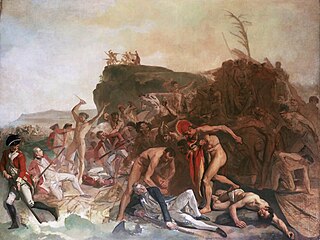
The Death of Captain James Cook, 14 February 1779 is a painting by Johann Zoffany. The painting records the loss of the British explorer Captain James Cook. The painting was completed in 1794 some years after the death of Cook in 1779. Other paintings of the death of Cook were painted earlier. The Mahiole that was included in the painting of Cook's death by Zoffany is said to be the helmet given to Cook when he first landed in Hawaii.
William Devonshire Saull was an English businessman, known now for his activities as geologist, antiquary and museum-keeper, philanthropist and supporter of radical causes.
The Rotunda radicals, known at the time as Rotundists or Rotundanists, were a diverse group of social, political and religious radical reformers who gathered around the Blackfriars Rotunda, London, between 1830 and 1832, while it was under the management of Richard Carlile. During this period almost every well-known radical in London spoke there at meetings which were often rowdy. The Home Office regarded the Rotunda as a centre of violence, sedition and blasphemy, and regularly spied on its meetings.
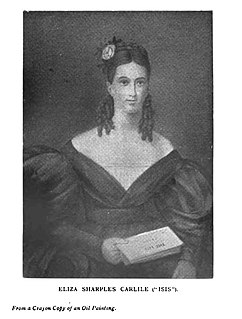
Eliza Sharples (1803—1852) was one of the first women in England to lecture on freethought, radical politics and women's rights. Using the names the Lady of the Rotunda and Isis, she delivered her lectures at the Blackfriars Rotunda in 1832, while it was under the management of her partner, Richard Carlile. Her speeches, together with writings by Carlile, herself and others, appeared in her weekly journal, The Isis.

Leicester House was a large aristocratic townhouse in Westminster, London, to the north of where Leicester Square now is. Built by the Earl of Leicester and completed in 1635, it was later occupied by Elizabeth Stuart, a former Queen of Bohemia, and by the Hanoverian Princess of Wales.

Susannah Wright was an English woman imprisoned on charges of Blasphemous libel for selling works from the shop of radical publisher Richard Carlile. In total, Wright served two years in Newgate and Coldbath Fields prisons, gaining a level of notoriety as the 'She-Champion of Impiety'.





















